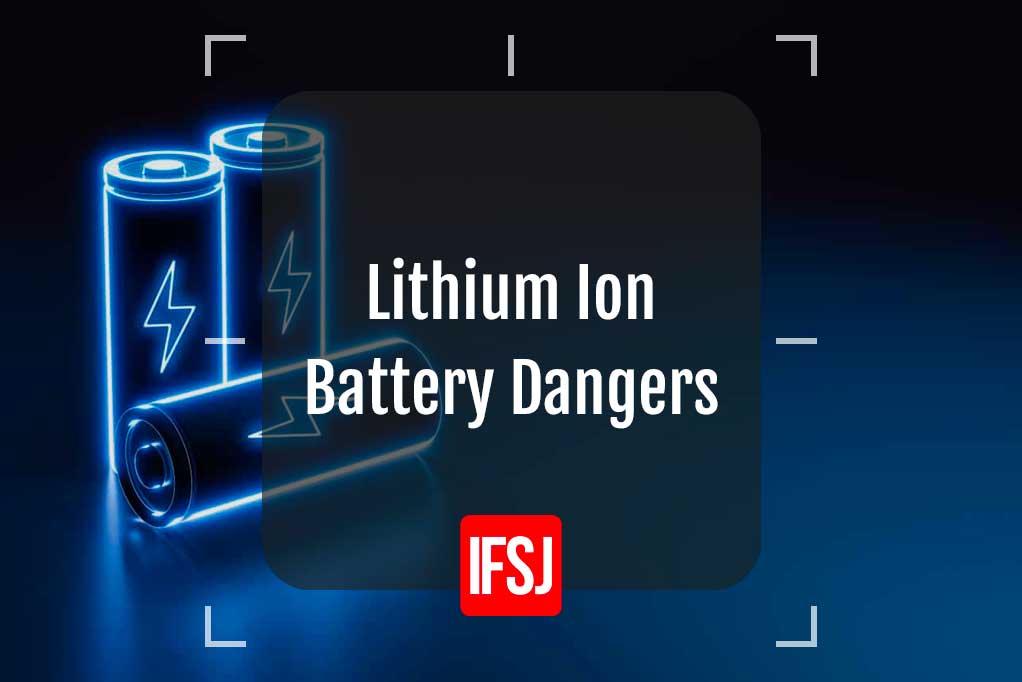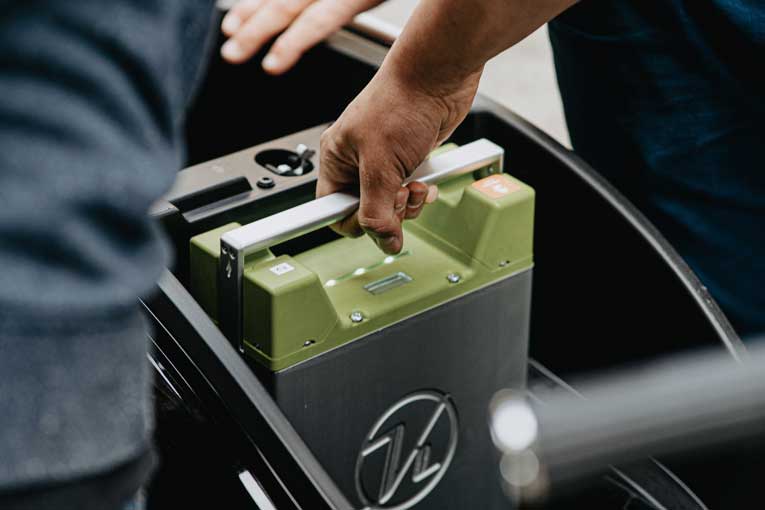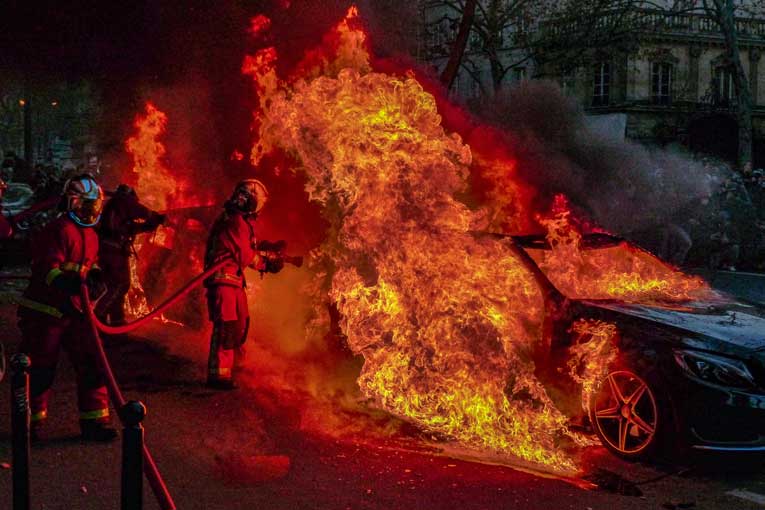Lithium Ion Battery Dangers: Understanding the Risks
- March 20, 2023
- 8:54 am


Iain Hoey
Share this content
Lithium-ion batteries (LIBs) are widely used in portable electronics and electric vehicles (EVs), and they are now a part of everyday life.
Lithium-ion batteries offer a number of advantages, but if damaged, mishandled or poorly manufactured, they can suffer stability issues and be subject to what is called a ‘thermal runaway‘.
Thermal runaway is a chain reaction within a battery cell that can be very difficult if not impossible to stop once it has started.
It occurs when the temperature inside a battery reaches a point that causes a chemical reaction to occur inside the battery.
This chemical reaction produces even more heat, which drives the temperature higher, causing further chemical reactions that create more heat.
In thermal runaway, the battery cell temperature rises incredibly fast, often within seconds and the energy stored in that battery is released very suddenly and violently.
This chain reaction creates extremely high temperatures and if the right conditions exist, significant explosions.
The associated hazards then are fire, explosion, electric arc flash, highly toxic gases/fumes, chemicals, potentially high voltage, potentially high currents.
In addition to the super high temperatures generated by a Thermal Runaway incident, the “smoke” emanating from a lithium-ion battery fire is actually a vapour cloud containing a cocktail of highly toxic acids.
This includes hydrogen cyanide, hydrogen fluoride, and hydrogen chloride as well as gases such as methane and ethane and other toxic organic compounds such as benzene, styrene and acrolein.
This cloud is lethal to an unprotected person.
The thermal runaway phenomenon is well recognised, and it can be mitigated against providing awareness and prevention actions are taken.
The aim of training is to raise awareness of the hazards of lithium-ion battery systems, and to assist and support employees to work safely around LIB battery systems and to educate people of the risks within their own homes.
What’s Being Done to Combat Lithium Ion Battery Fires?

Considerable research is being undertaken to determine why thermal runaway occurs and how it can be prevented.
LIB manufacturers are also looking to build detection and extinguishing capacity into LIBs, but all this will take time and considerable cost.
This is why as Fire Safety specialist we feel training is essential in the interim period.
We have also, with our associates, produced thermal material sacks and thermal blankets with built in detection until LIBs are safer and easier to extinguish.
Training on Lithium Ion Battery Dangers
JGS Fire Safety has been working with the world’s leading scientists, fire experts and energy engineers.
Their aim is to develop a series of online Lithium-ion Battery Safety courses for personnel who handle, store, transport or work in the vicinity of lithium-ion batteries and those who may have to extinguish the fires or deal with an incident.
In addition, with more people working remotely, the potential risk for incidents within the home is increasing and these types of incidents are routinely being reported in the media around the world.
The courses are the only ones approved by the Institute of Fire Safety Managers (IFSM) and have CPD accreditation.
They are also accredited with the Nautical Institute for the maritime environment.
At JGS Fire Safety, they consider it essential that clients have training ratified by external independent accreditors.
Why Were Online Courses Developed?

We work with companies who provide risk assessment and risk mitigation in high-threat environments and LIBs were being recorded as having started fires, or gassed off, in these environments.
Very few people were aware of the thermal runaway phenomenon at the time, so they set about finding out about the associated risks because many clients were using LIBs.
In doing so, they realised that an LIB incident is particularly hard to deal with and that many Fire Services had not, at the time, set up any Standard Operating Procedures to deal with them.
Currently there are no ISO’s for dealing with lithium ion battery dangers and most British Standard/EU Standards, or sector specific guidance, deals only with the construction of batteries.
They also realised no awareness courses existed.
Thus, they identified the problem and then implemented practical operational solutions and training to mitigate the risks to our clients.
Who Are the Courses For?
The courses are for people who handle, store, transport or work with lithium ion battery powered devices such as laptops, mobile phones, tablets, tools, appliances or energy storage equipment and electric vehicles.
This could be in their workplace, in their homes, travelling or during leisure time.
Currently people that are doing courses come from the maritime Industry, waste services, e-bike providers, fire safety managers, H&S Inspectors, mining, transport providers, cadet corps and school children.
They are in discussions with a local authority Fire & Rescue Service to provide courses to their Protection Officers initially.
These officers liaise directly with businesses within their areas and following the initial courses it is proposed to offer the courses to all operational and non-operational staff.
They offer greatly reduced course rates for the Emergency Services as a way of giving back to the people who gave me my opportunity in fire safety and who continue to do such great work for us all.
What Do the Courses Cover?
Module 1
Awareness of LIBs – ensures that students will be able to understand the hazards and dangers of lithium ion batteries, identify warning signs for lithium-ion battery incidents – especially potential vapour cloud explosion and thermal runaway fires and recall initial action if you are the first person on scene at a potential gas venting or fire.
Module 2
Dealing with LIBs Incidents – ensures the students understand the hazards and risks lithium ion battery fires pose; understand how you can potentially prevent and/or spot a LIB overheating; the initial actions you must take if you are the first trained person on scene; various techniques you can use to fight a lithium-ion battery fire and what to expect if the fire is out, but the battery is in thermal runaway; understand the structure of operational response (bronze) and tactical response (silver); and ways in which you can prevent a lithium-ion battery fire from occurring, looking at best practice.
Module 3
Strategic Management of LIBs – aims to build on the learning from our level 1 and 2 courses which considered the hazards and how to deal with lithium battery incidents.
The assumption is that anyone undertaking this course has completed at least one of these previous courses and has a working knowledge of the risks.
The learning aims of this course focus on how a student would assess and deal with a significant lithium ion battery fire in their business or organisation.
It stresses the importance of developing proper procedures for dealing with the dangers and challenges their staff could potentially face.
The course focuses on three areas of priority:
- early Information and detection (EI)
- early Intervention (EI)
- Operational Handover to emergency services (OH).
By the end of Module 3 the student will be able to: understand the risks – and understand the importance of EI, EI, OH, and what systems can be adopted to implement a successful fire strategy, deploy a solution, understand ways to contain Lithium-Ion battery fires, especially the importance of textile solutions and textile innovation, and understand the post incident actions to take following a thermal runaway incident.
Why Should People Undertake the Training?
At this time LIB fires are extremely difficult to extinguish safely and the gasses that are given off are extremely poisonous.
The fire is intense and at times explosive.
Fire spread is rapid and containment is challenging.
For these reasons JGS Fire Safety provide the courses that will help reduce the risk to the workplace, the home, and anyone who may have to deal with an incident.
Why wouldn’t you want to undertake this training?
We all have a duty of care, both to ourselves and to others.
For more information on JGS’s training courses contact [email protected] or visit the JGC Fire Safety website: at www.jgsfiresafety.co.uk.
This article was originally published in the March edition of IFSJ. To read your FREE digital copy, click here.
About the Author
Guy Solly is the Director at JGS Fire Safety Limited.
he joined the Fire Service in January 1986 aged 19 and little did he know the impact it would have on his life.
He served his whole fire service career within Essex, starting as a firefighter in Tilbury, before moving to Orsett when the Tilbury Station was closed.
Afterwards he got promoted and moved to serve in Grays, where finally after a total of 25 years riding fire appliances operationally he got promoted into the Technical Fire Safety Department as an Inspecting Officer.
This role gave him a greater insight into fire safety as a whole and provided the training and knowledge to assist others during his time within that department and then also following his retirement in October 2016.
He established JGS Fire Safety Ltd when he retired, with the aim to provide guidance, assistance, and support to clients and to raise the awareness of the fire safety issues which impact on everyone’s workplace and home environments.
They work with individuals and companies who are working on new ways to address the potential issues with lithium-ion batteries.
They are developing new ways of mitigating the effects of an incident and ways of dealing with a fire situation quickly, effectively, and safely.



